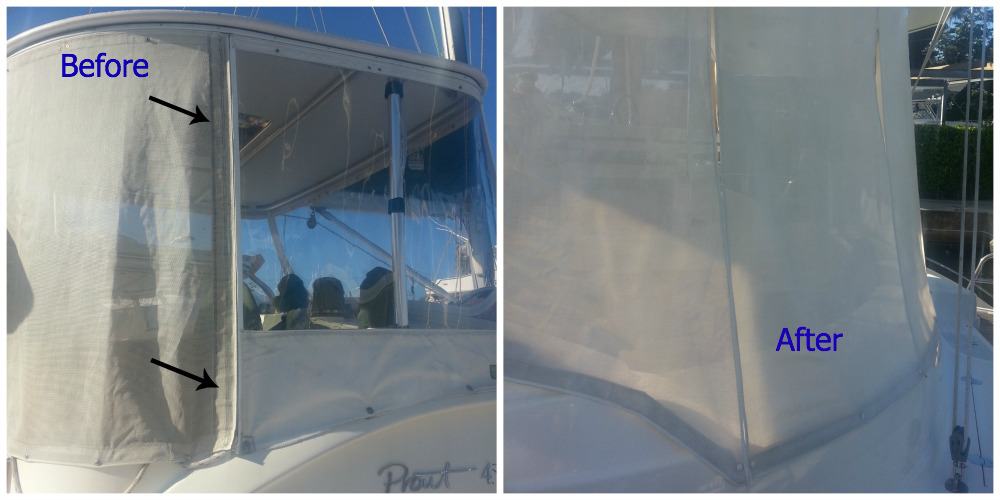Textilene Fabric Care & Maintenance
 I had to clean my Textilene sunshades on our catamaran this weekend. The was black in places from months sitting in the dirty boat yard. I did not look forward to the job because I knew that it would take a lot of elbow grease. I did some research and got these good tips from parkbenchdesigns.com and I did not have to do too much scrubbing!
I had to clean my Textilene sunshades on our catamaran this weekend. The was black in places from months sitting in the dirty boat yard. I did not look forward to the job because I knew that it would take a lot of elbow grease. I did some research and got these good tips from parkbenchdesigns.com and I did not have to do too much scrubbing!
Textilene® is a strong mesh fabric woven out of strong PVC-coated polyester yarns. The fabric is made especially for outdoor use. It is the best choice for sling furniture because it is elegant, strong and very durable to outdoor exposure.
Some of the most frequently asked questions about fabric are concerns about care and cleaning. The good news is that Textilene® is designed for outdoor use and easy maintenance. By following a few simple care and cleaning steps, these fabrics will maintain their good looks for many years. These fabrics can be cleaned while still on a frame or they can be removed before treating and scrubbing.
How to Clean Textilene®
Follow these simple steps:
- Brush off loose dirt.
- Hose down.
- Prepare a cleaning mixture of water and mild, natural soap (no detergents).
- Use a soft bristle brush to clean.
- Allow soap to soak in.
- Rinse thoroughly.
- Air dry.
Removing Stubborn Stains from Textilene
If stubborn stains persist, you can use a diluted chlorine bleach/soap mixture for spot cleaning of mildew, roof run-off, and other similar stains.
- Prepare a special cleaning mixture:
- Four ounces (half cup) of chlorine bleach
- Two ounces (one-fourth cup) of natural soap (no detergents)
- One gallon of water.
- Clean with soft bristle brush.
- Allow mixture to soak for up to 20 minutes.
- Rinse thoroughly.
- Air dry.
- Repeat, if necessary.
Preventing Stains from Setting in Textilene
Regular Maintenance
One of the best ways to keep Textilene® fabrics looking good and to delay the need for deep cleanings is to hose the fabric off on a monthly basis with clear water. This practice will help eliminate the need for more frequent vigorous cleanings. In most environments, a thorough cleaning will be needed every two to three years.
Avoid using suntan oil on or around your Textilene. Also, when possible, help your guests and any animals aboard avoid exposing the fabric to spills. But, your boat is for enjoyment, so accidents do happen. Here are some tips on how to avoid letting the inevitable stain your Textilene.
Immediate Removal of Spills on your Textilene
To prevent a stain from setting in on your Textilene, it is important to remove the spill immediately. Here is how to remove each type of stain to keep your fabric in top-top-shape:
Food Stains
- Chocolate – Rinse with cold water, if necessary, sponge with bleach.
- Coffee – Rinse with cold water, if necessary, sponge with detergent and water.
- Tea – Mix 1 tablespoon borax with 1/2 cup cool water, then scrub the stain with the solution. No borax? Then drench the stain with lemon juice, cover with plastic (tarp, bag, plastic wrap, etc.) to keep it moist, then expose to the sun for a day or two. If you have a difficult area to keep moist, use the lemon juice with some salt to hold the liquid on the stain…just remember to cover to keep moist.
- Alcoholic Beverages – Rinse with cold water then drench with white vinegar. Rinse with cold water.
- Sugar – Sponge with hot water. Rinse. Repeat if still sticky.
- Butter – Rinse with hot water
- Chewing Gum – Apply ice to harden, rub with your fingers, reapplying ice as necessary to keep it hard as you work it off the fabric. If residue remains, then sponge with Perchloroethylene spot remover.
- Milk or Cream – Sponge with Perchloroethylene spot remover.
- Mustard – Apply warm glycerine then wash with sudsy water and Hydrosulfite bleach. Don’t have all those products? Try rinsing and blotting as much as possible if you find the stain quickly, then use a general spot remover, then brush with water and soap. Air dry out of the sun. If stain remains, use repeat the process.
- Egg – Rinse with cold water, sponge with detergent and water.
- Fruit – If the stain is fresh, pour boiling water through stain (be careful!). If the stain is set in blot with hydrogen peroxide or hypochlorite bleach using a clean cloth, turning the cloth frequently.
- Ice Cream – Sponge with Perchloroethylene spot remover.
Bodily Fluids
- Blood-Rinse in cold water, then dilute ammonia, sponge with detergent and water, then rinse thoroughly
- Perspiration-Sponge with peroxide and ammonia, rinse with water
- Urine – Blot with a clean cloth. Use one tablespoon dishwashing liquid in two cups of cold water and a clean white cloth to apply the solution. Then use a dry cloth to blot the affected area until dry.
- Tears – (a tip you may need if you have these stains!), wash with shampoo, then rinse with water.
Other Common Stains
- Lipstick – Sponge with rubbing alcohol or Perchloroethylene spot remover.
- Grass – Sponge with alcohol, then a mild detergent and water solution.
- Ink (Pen) – If fresh, sponge with detergent and water. If dried, sponge with bleach, then oxalic acid (a spot remover), and then scrub with detergent and water.
- Ink (Ballpoint) – Scrub with detergent and water, then rinse. For stubborn stains, use petroleum jelly, let set for 30 minutes, then sponge with Perchloroethylene (spot remover). Some inks dissolve in glycerine and can be washed away with shampoo.
- Iodine – Sponge with alcohol changing sponge until stain is removed.
- Iron Rust – Sponge with oxalic acid (a spot remover), rinse well. Don’t have oaxlic acid? Spread salt on the stain then moisten the salt with lemon juice, cover with plastic (tarp, bag, or plastic wrap to keep moist, then place in the sun for 2-3 days.
- Oil – Scrub with detergent and water, then sponge with Perchloroethylene spot remover, if necessary.
- Paint
- Latex or Acrylic paint
- If not dried, latex and acrylic paints will wash away with soapy water.
- If it has dried, scrub with a soft bristle brush to get flakes off. Pour rubbing alcohol (or even better hand sanitizer since it is a gel alcohol) over the stain and let it sit for a few minutes. Brush again, then repeat applying alcohol and brushing. When you think you have the stain out, follow the
- Oil-based paint
- If it is not dried, use the recommend solvent from the paint can on an inconspicuous area of the Textilene. Then, as quickly as possible remove as much of the paint as possible with clean cloths. Then put down layers of paper towel and continually apply the solvent working the paint off the fabric. This must be done outdoors.
- If the oil-based paint is dried, first scrub with with detergent and water, then sponge with Perchloroethylene spot remover or turpentine.
- Latex or Acrylic paint
- Mildew – Sponge with bleach, followed by water rinse. Or spread salt on the stain then moisten the salt with lemon juice, cover with plastic (tarp, bag, or plastic wrap to keep moist, then place in the sun for 2-3 days.
- Tar – Moisten with a spot remover like Perchloroethylene. Scrape off then use the same spot remover with a sponge to remove the remaining residue.
- Adhesive Tape Residue – Harden with ice (fill a sandwich bag). Then, rub off with fingers. Re-apply the ice to harden, as necessary.
- Acid – Neutralize with ammonia. Rinse with cool, clean water. Air dry.
- Alkali – Neutralize with white vinegar. Rinse with cool, clean water. Air dry.
These tips will help get your fabrics aboard your boat or even on your dock looking bright and inviting once again. What are your tips for cleaning or maintaining Textilene?






